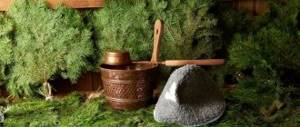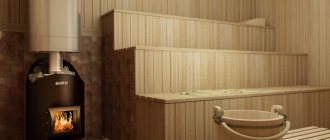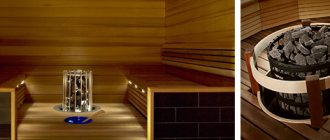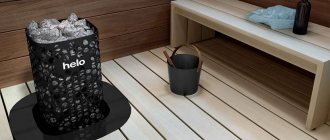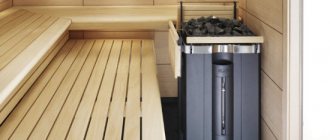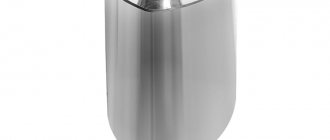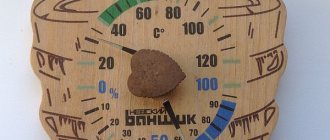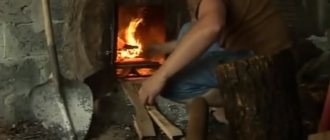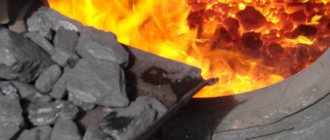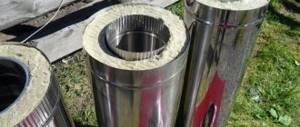How many stones should I put?
You can calculate how many kg of stones you need in a sauna stove yourself; let’s try to do this using a simple example.
So, for example, let’s take the original data:
- The volume of the steam room (excluding the stove) is 15 m3 - quite large.
- We use basalt stone.
- Creating steam every hour 3 times, at the rate of 70 ml/m3, then the stove consumes 0.07x15x3= 3.15 liters of water/hour.
- The operating time of the bath is 5 hours.
- The initial temperature of the stones (measured at a depth of 9-13 cm) is 500 degrees.
- The final heater temperature at which steam can still be produced is 150.
- The temperature of saturated steam from the heater is 110 degrees.
- The temperature of the supplied water is 80 degrees.
Now the calculations:
- The total amount of water poured onto the heater in 5 hours is 4.5 x 5 = 15.75 liters.
- To adjust water from 80 to 100 degrees you need: W1=15.75x1x(100-80)=315 kcal
- In order for this water to become steam: W2=15.75×538=8473.5 kcal
- Next, to heat the steam to 110 degrees: W3 = 15.75 × 0.48 × 10 = 75.6 kcal
- So, all you need is: W1+W2+W3 =8864.1 kcal
- 1 kg of stone, cooling from 500 to 150 degrees, releases heat: W4=C*(Tt)=0.15(500-150)= 52.5 kcal
- Total stones required: P = 8864.1/52.5 = 168.84 kg.
Again, this is conditional data; in reality, everything may differ. But now you know that approximately 1m3 of steam room volume (excluding the stove) accounts for 11 kg of stones.
Is it possible to mix stones for a bath?
When placing stones in a sauna stove, place different types, you do not harm either the heater or the air. On the contrary, mixing is used for aesthetic, medicinal, and technical purposes.
Stones are mixed to save money, due to the impossibility of filling the kiln completely with expensive stones. They can be laid either scattered or in layers; one option is to place faster-heating types on the bottom so that heating occurs more easily.
An equally important part of the steam room is aesthetic pleasure; beautifully arranged rocks of different colors, black shades and red, gray and green, will amuse the users of the bath.
Choosing the shape and size of stones
Placing stones in the sauna stove of the correct size and shape is the key to good and light steam. The shape affects the amount of water retained.
The ideal would be to choose a tumbled or chipped form. The chipped ones are quite large in area, the minus is strength, frequent cracks and breakages. Galvanized ones are the most durable, tumbling eliminates fragile samples, the area is not inferior to crushed cobblestones, the minus is the high cost. Do not buy smooth, polished cobblestones; the “moisture retention” parameter suffers extremely.
The size is divided into three fractions, small, normal and large. 5-12 centimeters is a suitable size. According to the rules, large fractions are placed on the bottom layer, then normal and small ones on top.
Equipment of furnaces with water tanks
Furnace units usually available for sale , but Vesuvius produces various options for containers, and the buyer can choose one of them:
- rectangular tanks are divided into those mounted on a pipe (capacity from 50 to 80 l) and mounted structures (from 60 to 125 l);
- oval tanks are mounted on a pipe, cut into the contour, placed vertically or horizontally, their displacement is provided in the range from 55 to 90 liters;
- round and flat heat exchangers from 6 to 12 liters are connected to the water supply system or included in the heating circuit.
Reviews from users of domestically produced Vesuvius stoves sound positive, but among them there are dissatisfied ones. Furnaces have been so improved since they were first released that their poor performance is due to improper use.
We purchased the “Legend” stove from the “Vesuvius” series. It took a long time to get used to it, but over time we understood the whole system, read the recommendations, and began to put it into practice. Now let's not boast about heating perfection. We installed a tank, now the hot water is heated and the bathhouse is always warm.
Our stove had bad steam and neither we nor our guests and friends liked it. Then, on the advice of specialists, they made tubes for the stones, it became much better, as steam comes out with completely different properties. True, it’s a little troublesome to charge it all, but the steam room turns out to be excellent.
We have Vesuvius, but my husband covered it with red brick to improve its performance. We have not tried other stoves, we are quite satisfied with this one, we heat and steam slowly, and we get the benefits. It’s a good stove, no problems at all, we’ve had it for four years now.
What stones should not be placed?
The following minerals are contraindicated for use:
- Granite.
- Quartz.
- Spar.
- Mica.
- Pyrite.
- Electroporcelain.
- Marble.
- Limestone.
- Flint.
Such minerals contain harmful elements such as sulfur, iron, and decay products of radionuclides that release radioactive gases.
Laying algorithm
Stone minerals have the characteristics of “thermal conductivity” and “heat capacity”. Baths are built “convection” or not, convection quickly warms up the air, preventing the heat from stagnating in the rocks.
This method will give a short-term fire. Proper placement of stones in a sauna stove will help warm up the stones, which will give off heat to the air for a long time, the steam will become lighter and the room will retain heat longer.
Using the instructions, you can achieve better heating of minerals in a short time:
- The correct placement of stones in a long-shaped sauna stove is not horizontal, but vertical, on its side. There are explanations for this; when warming up, gaps are needed through which heat passes for air circulation.
- You cannot stack stone blanks tightly; when heated, expansion occurs and tightly packed stones begin to break under each other’s pressure.
These actions prolong the performance of the filler and increase the rate of heating of the room.
The two types of ovens, open and closed, require different lining methods. Correct placement of stones in a sauna stove ensures heat accumulation and, therefore, good steam generation:
- Closed heaters are filled with filler according to the instructions and closed with a door; there are no questions about the amount of filler.
- Open stoves cause bewilderment, the question arises: “How high should I put it?” Stones are placed in the sauna stove up to the top of the walls; those that lie above the wall warm up worse.
Model ranges of Vesuvius stoves
Among those where an open heater is installed, the most spectacular and unusual are the models of the Vesuvius Vertical series. The external dimensions of all modifications are the same (WxDxH = 540x790x1010 mm), the difference lies in the design of the door covering the combustion tunnel. Some doors have panoramic glass or regular heat-resistant glass, others have no glass at all. This line, the cost of various models of which ranges from 12 to 20 thousand rubles, is capable of heating steam rooms with a volume of 8-18 m3.
Furnace Vesuvius-Vertical
"Vesuvius-Vertical"
The “Vesuvius Skif” and “Russian Steam” lines also have an open heater, which are distinguished by a wide variety of sizes and door designs. Thus, “Russian Steam” has six modifications that are capable of heating steam rooms ranging in size from 18 to 23 m3 and the average cost of which is in the range from 24 to 27 thousand rubles.
Furnace Vesuvius Skif
"Vesuvius Scythian", model SCH12
“Scythians” have 26 options that are capable of heating rooms of almost any size and which are distinguished by a wide variety of designs for the doors of the combustion portal. With an abundance of options, the price range is also wide - from 10 to 25 thousand.
Vesuvius Elite stove
"Vesuvius Elite", lined with coil
In Vesuvius Elite stoves, which attract attention with their appearance, their own coil plays the role of lining. The combustion tunnel door of these stoves is decorated with built-in glass. There are relatively few modifications in this series, and their prices start at 40 thousand rubles.
Vesuvius Lava Furnace
Sauna stove Vesuvius Lava
The line with a closed heater is represented by the popular Vesuvius Lava stove, the distinctive feature of which is the forged decorative linings that decorate the body. This series has a large number of modifications (currently there are 24), differing in power, overall dimensions, the presence or absence of a fuel tunnel, door glazing or its absence. Buyers can choose from this series such sauna stoves that are capable of heating steam rooms measuring 6-28 m3. The abundance of models also implies a wide range of prices, which range from 12 to 28 thousand rubles.
Furnace Vesuvius Rusich
"Vesuvius Rusich"
Sauna stoves "Vesuvius Rusich" are produced without forged elements on the surface of the body, but this does not matter for those bath lovers who intend to surround the stove with a brick screen, which improves the quality of the steam, which more fully meets the requirements of the Russian steam room. The price of the product is 16-18 thousand rubles.
Furnace Vesuvius Legend
Sauna stove Vesuvius Legend
The “Legend” line, made of cast iron, has a fairly significant weight (about 160 kg), has an open-type heater and a combustion tunnel. Such sauna stoves are capable of heating steam rooms measuring 10-28 m3. Various models cost from 14 to 23 thousand.
The advantages of Legend stoves are described in detail in the video we offer.
Video – Sauna stove Vesuvius Legend
Each line includes fireplace stoves equipped with doors with wide panoramic heat-resistant glass.
Lifetime of stones
The service life of the filler depends on the breed and quality. Over the course of a year, there is a high chance that some stones will become unusable and will have to be replaced. Ideally, a complete replacement takes place every three to four years. This is due to the following factors:
- Pollution. Toxins and dirt accumulate on minerals.
- Wear. Most of the heat capacity is lost through cracks and fractures.
- Unpleasant appearance. Old things get boring, and going to the bathhouse brings less pleasure.
In order for wear to occur more slowly, you should avoid temperature changes, do not pour cold water on the stones and do not expose them to open fire. When placing stones in the heater, rinse them to remove dirt and avoid unpleasant odors.
How to properly prepare stones for a steam room
We all remember the phrase “And experience, the son of difficult mistakes” by Comrade Pushkin. The phrase “The longest and most expensive school is the school of your own life experience, but, unfortunately, fools do not want to study in another!” less known. Although, I must admit, Bernard Shaw is more honest. This happened to me when I finished the steam room, bought stones, which I immediately put in the heater and joyfully lit the stove. The result was terrible, as the steam room was filled with stench and hell. In general, the first bath did not go well, and I tried to figure out what was done wrong and how. As it turned out, everything was done wrong.
Which stones are better?
The best stones for a steam room are stone ones. And it’s no joke that you won’t find anything there, from cast iron balls to high-voltage insulators (by the way, from the point of view of temperature retention, these are not the worst options), but the first option will still be correct.
The stone must pass a simple test - heat it to 100-120 degrees (so that the water does not hiss, but bounces) and throw it into cold water. If it doesn't crack, it's suitable for the heater. Otherwise, stones are divided by price, caliber, type of processing, and today this is not a problem at all - any bath store has a selection of them.
So, the stones are divided:
— chipped, or rolled (they are also boned, rolled, etc., that is, those that do not have sharp corners); — small, medium and large (you should choose based on the size of the stove and heater); - natural or artificial (some artificial, with characteristics no worse than natural stones); — exotic options (salt rocks, fossils, ancient minerals, etc.).
In my case, the choice was banal - soapstone, as the most budget option, especially since a stove with a reserve of thermal power and there were no questions about the temperature in the steam room.
You should not think that a large heater volume can maintain the temperature in a steam room longer, this is not the case. Any sauna stove (except brick) is a “potbelly stove”. And the “potbelly stove” heats while the wood is burning in it. The volume of the stones makes the heat “softer”, that’s all.
The preparation process for the heater
In PHOTO 1, you can clearly see in what form the stones arrive. Nobody told me that they were not ready for use; on the contrary, it was written on the packaging that nothing needed to be done.
1
It was in this form that I loaded them into the steam room, after which I was forced to disassemble the heater and start preparing the stones. This task is not difficult, but it will take some time and is generally quite tedious. However, before going into the steam room, I strongly recommend that you complete all the procedures described below.
The first stage is to soak the stones in ordinary water (WITHOUT DETERGENTS!) for one and a half to two hours, waiting until they become slippery and “soapy” to the touch.
2
The second stage is to thoroughly scrub with a brush (a painter’s brush, a flexible base and stiff bristles were ideal for me), removing all dust and dirt.
3
After the stones have been cleaned (PHOTO 4) and acquired a natural color, fill them with water, and after half an hour - an hour, pour them with a running stream of water.
4
I had the opportunity, so the process was continuous, as I cleaned the stones, I placed them in the flow basin, cleaning the next one. In the next PHOTO, you can clearly see what exactly will end up in the lungs if the stones are not cleared. A layer of viscous soapy and foul-smelling liquid (four centimeters deep) in a white bucket is what is washed off them.
5
Technically, after soaking and rinsing, you can consider the preparation process complete and begin laying out the heater.
Improving the properties of stones
After the stones were washed and cleaned, I was not lazy and, having laid out the heater, heated it to a temperature of 110-120 degrees. This showed that not all of them were washed well PHOTO 6, and with those that turned out to be whiter, I repeated the washing procedure.
6
But that is not all. When all the stones (after the second calcination turned out to be dark green, which indicates purity, since this is the correct color of soapstone), I put a few of them back into the basin. True, there was no longer water in the basin, but a supersaturated salt solution. I made a mixture – table salt, sea salt, and a few crystals of “Himalayan” salt. Heated the mixture in a large saucepan until the table salt (coarsely ground) stopped dissolving. The stones lay in this solution for about two days.
To assess the salt impregnation of the stone, use a toothpick, which is placed on the top edge of the stone, almost level with the surface of the solution. The presence of crystals between the stone and the toothpick will indicate that the stone is saturated with salt (ideally, the toothpick will “stick”, as it happened for me).
How to lay stones correctly
In my case, everything was simple. The salted stones were left for the top. The purest ones went into the oven as the basis. I laid it out on the principle that the bottom of the heater MUST breathe. It is wrong to fill the bottom of the stove with small stones, because because of this, the top of the heater will not heat up properly - there will not be enough convective flows of heated air.
7
Before placing it in the oven, I laid out all the stones on the shelves (don’t forget to lay down a towel so as not to spoil the boards), so that they were all in front of my eyes, and choosing the right piece for laying was not a problem. The salted ones went to the top layer of the oven, and the rest to the final pyramid.
8
But the final pyramid is not entirely true, because after a few parks, we decided to increase the volume of the steam room. Not to retain heat - but to reduce the rigidity of the hot chimney pipe. The solution was inexpensive and simple. An ordinary stainless steel basket for 850 rubles, an overhaul of the heater (this was the fourth overhaul, but no one has yet refuted Bernard Shaw’s phrase), and another 20-kilogram box of soapstone stones, equally carefully processed, was added.
And this was a very correct layout of the heater. Clean and salted stones, an exact pyramid covering a “hot” pipe, and a salt brick nearby. All this together created an atmosphere of relaxation and pleasure in our steam room. True, I had to tinker a little to clean the shelves from the first “bath”, wiping off the greenish traces from unwashed stones, and I would have to repeat the washing process. Now the design will allow you to close the pipe and add some more stones. In the end, it took me 80 kg to bake. stones, and the time to warm up the steam room from 10 degrees to 90 remained at just over an hour.
